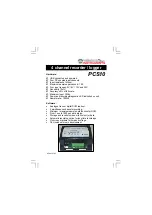
34 | 50
Installation Manual LOGS50 EN_MI_090221
Note that if the user specifies so, within the configuration, the frequency meter
value can suffer a zero-convergence algorithm. Supposing the value of the last
measured period
Tp,
as long as the elapsed time
from this last pulse is inferior
to
Tp,
the frequency meter value remains the same; when the elapsed time
form this last pulse is between Tp and 5 times Tp, the frequency meter value
start decreasing at a pace of weight of pulse / elapsed time form the previous
pulse; Once the 5 times Tp limit is exceeded, the frequency meter value is
truncated to zero. On the other hand, whatever it is the value of Tp, after an
hour has passed without entering new pulses, the value of the frequency meter
goes to zero.
1.12 +24 VDC / + 12 VDC POWER SUPPLY OUTPUT
LOGS50 has been designed with an assistant output for power supply which
provides an isolated voltage from the batteries. This output offers a +24V DC
voltage and its functioning can be linked to an analogical input reading so that
when the user configure a reading for an analog input, this output will be
automatically activated before that reading and will be deactivated again right
after that reading; this always happens on condition that the input have a pre
and post activation time different from zero (WARM UP TIME). Pre and post
activation times equal to zero mean that this output will not be activated- the
user will choose this option when the sensors connected to the logger are
externally powered to the unit. Activation times are configured by user by
means of the LOGS50 configuration program and must concur with the
excitation time needed by the sensor to operate.
Besides its operation as a punctual power source for analogical sensor feeding
purposes, this output can also be activated as a general purpose output always
bearing in mind that if the logger works only with internal batteries the more this
output is used the less the internal battery will last.
The selection between +12 VDC and +24 VDC is done by means of SW5
microswitch.
3 The value stored in the period measurement corresponds to the result of dividing the accumulated value of the associated
input by the elapsed time from the last input activation. This quotient it adjusted so that the measurement time interval coincides
with the one requested by user. (Example: a totalizer input has been assigned with an increment of 5m3 and it is has been
measured a period of 10s between activations which provide a flow rate of 0.5 m3/s. If the user stablish that the period for the
calculus is 60s then, the stored value will be equal to 30m3/min).
















































